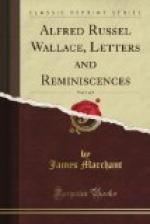The scientific discoveries arising out of these eight years of laborious work and physical hardship were first—with the exception of the memorable Essay on Natural Selection—included in his books on the Malay Archipelago, the Geographical Distribution of Animals, Island Life, and Australasia, besides a number of papers contributed to various scientific journals.
A bare catalogue of the places visited and explored includes Sumatra, Java, Borneo, Celebes, the Moluccas, Timor, New Guinea, the Aru and Ke Islands. Comparing this list with that given by Darwin at the close of the “Journal,” we find that though in some respects the ground covered by the two men was similar, it never actually overlapped. The countries and islands visited by the Beagle came in the following order: Cape de Verde Islands, St. Paul’s Rocks, Fernando Noronha, South America (including the Galapagos Archipelago, the Falkland Isles, and Tierra del Fuego), Tahiti, New Zealand, Australia, Tasmania, Keeling Island, Maldive coral atolls, Mauritius, St. Helena, Ascension. Brazil was revisited for a short time, and the Beagle touched at the Cape de Verde Islands and the Azores on the homeward voyage.
The very nature of this voyage did not permit Darwin to give unlimited time to the study of any particular spot or locality; but his accurate observation of every detail, together with his carefully kept journal, afforded ample scope and foundation for future contemplation. To Wallace, the outstanding result may be summed up in the fact that he discovered that the Malay Archipelago is divided into a western group of islands, which in their zoological affinities are Asiatic, and an eastern, which are Australian. The Oriental Borneo and Bali are respectively divided from the Australian Celebes and Lombok by a narrow belt of sea known as “Wallace’s line,” on the opposite side of which the indigenous mammalia are as widely divergent as in any two parts of the world.
To both men Darwin’s estimate of the influence of travel may aptly apply in the sense that from a geographical point of view “the map of the world ceases to be a blank ... each part assumes its proper dimensions,” continents are no longer considered islands, nor islands as mere specks.
Wallace’s homeward journey was not so eventful as the previous one had been, except for the unsuccessful efforts to bring back several species of live birds, which, with the exception of his birds of paradise, died on the way. On reaching London in the spring of 1862, he again made his home with his married sister, Mrs. Sims (who was living in Westbourne Grove). In a large empty room at the top of the house he found himself surrounded with packing-cases which he had not seen for five or six years, and which, together with his recent collections, absorbed his time and interest for the first few weeks. Later, he settled down to his literary work, and, with the exception of one or two visits to the Continent and America, spent the remainder of his life in England—a life full of activity, the results of which still permeate scientific research.




